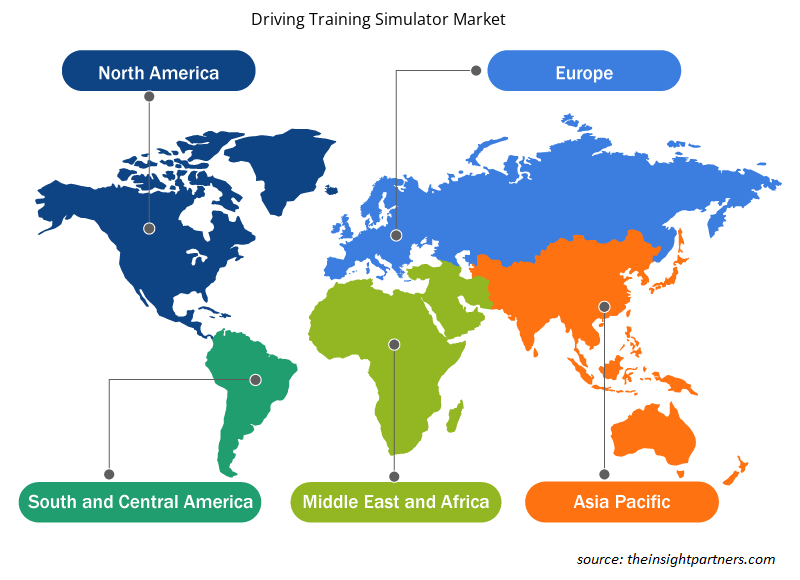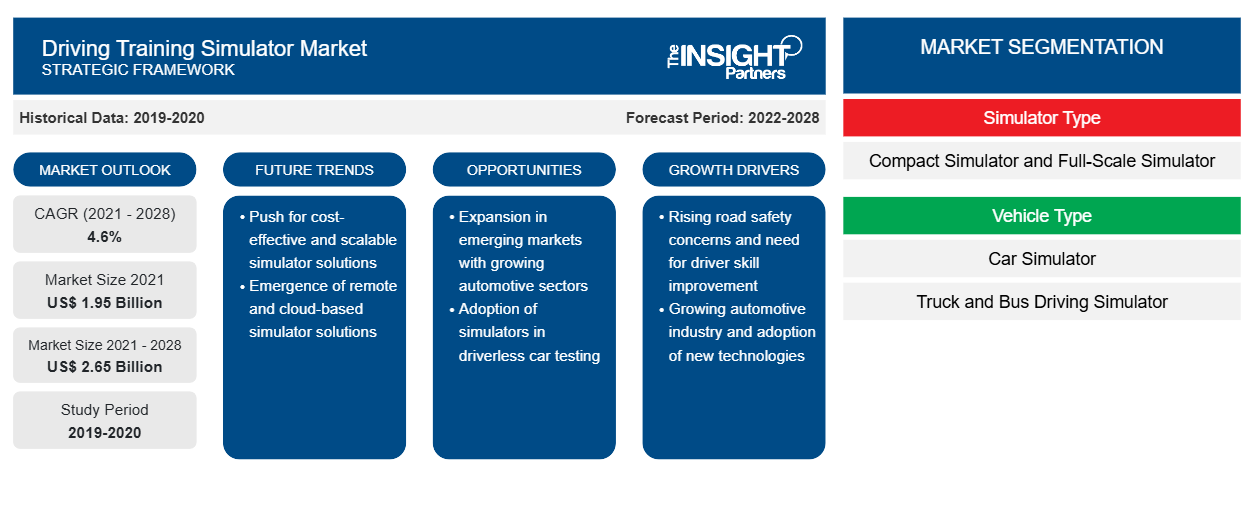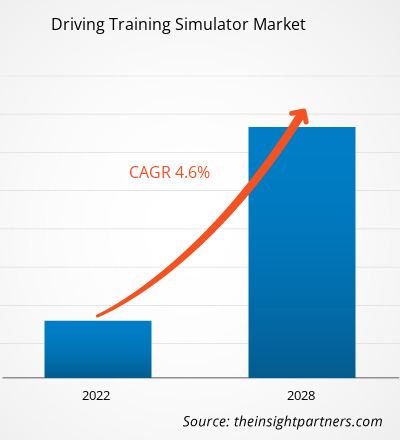2021 年全球驾驶训练模拟器市场价值为 19.5 亿美元;预计 2022 年至 2028 年的复合年增长率为 4.6%
由于交通事故增加、空中交通拥堵、即将启动的高铁项目以及对自动驾驶汽车的大量研发投资,对专业驾驶员的需求不断增加。这反过来又推动了发达国家和发展中国家市场的增长。全球机场和空中交通项目的扩张、警车和应急车辆的模拟器以及自动驾驶和半自动驾驶汽车的快速发展预计将在预测期内推动市场的增长。然而,实时控制方面的挑战、缺乏规范和标准以及集成的复杂性可能会阻碍驾驶训练模拟器市场的发展
在汽车测试的各个阶段,驾驶训练模拟器在汽车和相关行业中越来越受欢迎。工程师和研究人员目前正在利用这项技术在虚拟环境中真实地了解车辆的整体性能,从而帮助改进车辆设计和系统性能。飞行模拟器还用于军事和航空业,以训练飞行员驾驶民用和武装部队飞机。
定制此报告以满足您的需求
您可以免费定制任何报告,包括本报告的部分内容、国家级分析、Excel 数据包,以及为初创企业和大学提供优惠和折扣
- 获取此报告的关键市场趋势。这个免费样品将包括数据分析,从市场趋势到估计和预测。
自动驾驶汽车必须在各种环境中经过广泛的研究和测试才能上路。彻底验证自动驾驶汽车所需的罕见和危险事件很难体验。NVIDIA DRIVe Sim 解决了这些问题,这是一个物理上精确的模拟平台,可以生成接近真实情况的合成数据。借助 DRIVE Sim,自动驾驶汽车 (AV) 工程师可以提高产量、效率和测试覆盖率,同时减少真实驾驶并加快上市时间。驾驶模拟器使用高保真和物理上精确的模拟,开发了一种经济高效、可扩展的方法,将自动驾驶汽车引入道路。它使用人工智能 (AI) 等基础技术来提供强大的基于云的计算平台,可以为 AV 的创建和验证生成各种真实情况。驾驶模拟器使用精确地图数据构建实际设置的数字孪生,并可以创建数据集来测试或训练车辆的决策或感知系统。它还可以连接到软件在环 (SIL) 或硬件在环 (HIL) 配置中的 AV 堆栈,以验证整个集成系统。
全球驾驶训练模拟器市场根据模拟器类型、车辆类型、最终用户和地理位置进行细分。根据模拟器类型,全球驾驶训练模拟器市场细分为紧凑型模拟器和全尺寸模拟器。就车辆类型而言,市场细分为汽车模拟器、卡车和公共汽车驾驶模拟器等。根据最终用户,市场分为驾驶训练中心、汽车 OEM和其他。按地理位置划分,市场细分为北美、欧洲、亚太地区、中东和非洲以及南美。2021 年,北美占据了整体市场的主导地位,欧洲在 2021 年占据了第二大市场份额。
COVID-19 疫情对驾驶训练模拟器市场的影响
新冠疫情严重影响了北美的汽车 OEM、供应商和供应链。由于不确定的经济危机,消费者购买大宗商品的意愿降低,导致新车需求下降。这同时影响了美国和加拿大的驾驶培训中心,减少了消费者需求。结果,乘用车驾驶训练模拟器市场萎缩。然而,从 2021 年开始,驾驶模拟器的需求出现了短暂的上升。参加体育赛事的驾驶员需要模拟训练和练习才能获得虚拟环境体验。此外,对虚拟模拟和安全的不断增长的需求使汽车制造商能够加入紧凑型模拟器和高级驾驶辅助系统 (ADAS) 等先进功能。
即使在新冠疫情爆发之前,汽车 OEM 和供应商的财务实力也很薄弱。受疫情影响,主要汽车供应商的营业利润同比下降。因此,北美汽车市场下滑,导致研发投资下降,尤其是在驾驶模拟行业。此外,福特和通用汽车的制造厂因安全和封锁协议而放缓了运营。然而,由于封锁放松以及北美政府为推动经济发展而推出的财政计划,2021 年需求有所复苏。
市场洞察 – 驾驶训练模拟器市场
对熟练驾驶员和驾驶安全预防措施的需求日益增加
为应对人为失误导致的事故增多,对能够在各种情况下驾驶车辆的经验丰富的驾驶员的需求正在大幅增加。由于驾驶训练模拟器可以借助虚拟环境教驾驶员如何从各个角度避免碰撞,因此对它的需求也随之增加,从而导致市场高速增长。技术进步和投资也使市场受益。
在世界各地,驾驶安全预防措施变得越来越重要。驾驶模拟器广泛用于有关安全和负责任驾驶的指导、测试和研究。虚拟驾驶模拟器可以成为道路测试的安全替代方案,用于进行研究、测试和培训。研究人员已经调查了研究和测试应用的各个方面,包括模拟器晕动症、疲劳和学习行为,以改善模拟驾驶情况,提高模拟器的有效性。
与众多机构和技术实验室的合作一直是研究应用的有效策略。例如,火车模拟器非常适合教新司机驾驶基础知识。这些便携式模拟器可以通过反应评估、感知测试和视力检查成功地传递指令。学员通过虚拟现实 (VR) 和有轨电车训练模拟器提供的学习体验学习如何操作有轨电车。速度、刹车和振动等参数受到密切关注,因为主管可以使用这些数字来衡量未来驾驶员的表现。因此,对熟练驾驶员和驾驶安全预防措施的日益增长的需求正在帮助驾驶训练模拟器市场
驾驶训练模拟器市场区域洞察
Insight Partners 的分析师已详细解释了预测期内影响驾驶训练模拟器市场的区域趋势和因素。本节还讨论了北美、欧洲、亚太地区、中东和非洲以及南美和中美洲的驾驶训练模拟器市场细分和地理位置。

- 获取驾驶训练模拟器市场的区域特定数据
驾驶训练模拟器市场报告范围
| 报告属性 | 细节 |
|---|---|
| 2021 年市场规模 | 19.5亿美元 |
| 2028 年市场规模 | 26.5亿美元 |
| 全球复合年增长率(2021 - 2028) | 4.6% |
| 史料 | 2019-2020 |
| 预测期 | 2022-2028 |
| 涵盖的领域 | 按模拟器类型
|
| 覆盖地区和国家 | 北美
|
| 市场领导者和主要公司简介 |
|
驾驶训练模拟器市场参与者密度:了解其对业务动态的影响
驾驶训练模拟器市场正在快速增长,这得益于终端用户需求的不断增长,这些需求源于消费者偏好的不断变化、技术进步以及对产品优势的认识不断提高等因素。随着需求的增加,企业正在扩大其产品范围,进行创新以满足消费者的需求,并利用新兴趋势,从而进一步推动市场增长。
市场参与者密度是指在特定市场或行业内运营的企业或公司的分布情况。它表明在给定市场空间中,相对于其规模或总市场价值,有多少竞争对手(市场参与者)存在。
在驾驶训练模拟器市场运营的主要公司有:
- 自动模拟系统
- 博世力士乐公司
- 克鲁登公司
- 达拉拉
- ECA集团
免责声明:上面列出的公司没有按照任何特定顺序排列。

- 获取驾驶训练模拟器市场顶级关键参与者概览
基于模拟器类型的见解
根据模拟器类型,驾驶训练模拟器市场分为紧凑型模拟器和全尺寸模拟器。
基于车辆类型的洞察
根据车辆类型,驾驶训练模拟器市场分为汽车模拟器、卡车和公共汽车模拟器等。宝马、特斯拉、本田和丰田等汽车制造商正在大力投资研发,以将自动驾驶汽车推向市场并改进现有汽车的设计或型号。
基于最终用户的洞察
根据最终用户,全球驾驶训练模拟器市场分为驾驶训练中心、汽车 OEM 和其他。汽车制造商正在投资开发可用于自动驾驶汽车的组件,包括传感器和处理器。
驾驶训练模拟器市场的参与者主要致力于开发先进、高效的产品。
- 2021 年 1 月,Adacel Technologies Limited 宣布与澳大利亚航空服务公司签订一份新的五年合同,为控制塔模拟器 (CTS) 提供支持服务。合同价值估计为 100 万美元。
- 2021 年 2 月,IPG Automotive GmbH 在德国斯图加特开设了新办事处,为客户和合作伙伴的项目提供更广泛、更直接的支持。
公司名单:
- 自动模拟系统
- 博世力士乐公司
- 克鲁登公司
- 达拉拉
- ECA集团
- IPG 汽车有限公司
- 穆格公司
- NVIDIA 公司
- 泰克诺特罗夫
- VI-grade GmbH
- 历史分析(2 年)、基准年、预测(7 年)及复合年增长率
- PEST 和 SWOT 分析
- 市场规模价值/数量 - 全球、区域、国家
- 行业和竞争格局
- Excel 数据集



Report Coverage
Revenue forecast, Company Analysis, Industry landscape, Growth factors, and Trends

Segment Covered
This text is related
to segments covered.

Regional Scope
North America, Europe, Asia Pacific, Middle East & Africa, South & Central America

Country Scope
This text is related
to country scope.
常见问题
The global driving training simulator market was valued at US$ 1950.00 Mn in 2021
The driving factors impacting the Driving training simulator market are:
1. Increasing Need for Skilled Driver and Driving Safety Precautions
2. Simulation for Training Autonomous Vehicle Driving Systems Algorithm
One of the prominent future trends impacting the driving training simulator market include integration of Virtual Reality in Driving Training Simulators
APAC is the fastest-growing regional market in the global Driving training simulator market in 2021.
The key players holding the major market share of driving training simulator are Autosim AS; Bosch Rexroth AG; Cruden B.V.; DALLARA; ECA Group; IPG Automotive GmbH; Moog, Inc.; Nvidia Corporation; Tecknotrove; and Vi-Grade GmbH.
US, UK, India, South Africa, and Brazil are the countries are registering a high growth rate during the forecast period.
The incremental growth of the driving training simulator market during the forecast period is US$ 623.6 million with a CAGR of 4.6%
The compact simulator segment led the driving training simulator in 2021.
The global driving training simulator market size is projected to reach US$ 2643.7 Mn by 2028.
Trends and growth analysis reports related to Electronics and Semiconductor : READ MORE..
The List of Companies - Driving Training Simulator Market
- Autosim AS
- Bosch Rexroth AG
- Cruden B. V.
- Dallara
- ECA GROUP
- IPG Automotive GmbH
- Moog Inc.
- NVIDIA Corporation
- Tecknotrove
- VI-grade GmbH
The Insight Partners performs research in 4 major stages: Data Collection & Secondary Research, Primary Research, Data Analysis and Data Triangulation & Final Review.
- Data Collection and Secondary Research:
As a market research and consulting firm operating from a decade, we have published and advised several client across the globe. First step for any study will start with an assessment of currently available data and insights from existing reports. Further, historical and current market information is collected from Investor Presentations, Annual Reports, SEC Filings, etc., and other information related to company’s performance and market positioning are gathered from Paid Databases (Factiva, Hoovers, and Reuters) and various other publications available in public domain.
Several associations trade associates, technical forums, institutes, societies and organization are accessed to gain technical as well as market related insights through their publications such as research papers, blogs and press releases related to the studies are referred to get cues about the market. Further, white papers, journals, magazines, and other news articles published in last 3 years are scrutinized and analyzed to understand the current market trends.
- Primary Research:
The primarily interview analysis comprise of data obtained from industry participants interview and answers to survey questions gathered by in-house primary team.
For primary research, interviews are conducted with industry experts/CEOs/Marketing Managers/VPs/Subject Matter Experts from both demand and supply side to get a 360-degree view of the market. The primary team conducts several interviews based on the complexity of the markets to understand the various market trends and dynamics which makes research more credible and precise.
A typical research interview fulfils the following functions:
- Provides first-hand information on the market size, market trends, growth trends, competitive landscape, and outlook
- Validates and strengthens in-house secondary research findings
- Develops the analysis team’s expertise and market understanding
Primary research involves email interactions and telephone interviews for each market, category, segment, and sub-segment across geographies. The participants who typically take part in such a process include, but are not limited to:
- Industry participants: VPs, business development managers, market intelligence managers and national sales managers
- Outside experts: Valuation experts, research analysts and key opinion leaders specializing in the electronics and semiconductor industry.
Below is the breakup of our primary respondents by company, designation, and region:

Once we receive the confirmation from primary research sources or primary respondents, we finalize the base year market estimation and forecast the data as per the macroeconomic and microeconomic factors assessed during data collection.
- Data Analysis:
Once data is validated through both secondary as well as primary respondents, we finalize the market estimations by hypothesis formulation and factor analysis at regional and country level.
- Macro-Economic Factor Analysis:
We analyse macroeconomic indicators such the gross domestic product (GDP), increase in the demand for goods and services across industries, technological advancement, regional economic growth, governmental policies, the influence of COVID-19, PEST analysis, and other aspects. This analysis aids in setting benchmarks for various nations/regions and approximating market splits. Additionally, the general trend of the aforementioned components aid in determining the market's development possibilities.
- Country Level Data:
Various factors that are especially aligned to the country are taken into account to determine the market size for a certain area and country, including the presence of vendors, such as headquarters and offices, the country's GDP, demand patterns, and industry growth. To comprehend the market dynamics for the nation, a number of growth variables, inhibitors, application areas, and current market trends are researched. The aforementioned elements aid in determining the country's overall market's growth potential.
- Company Profile:
The “Table of Contents” is formulated by listing and analyzing more than 25 - 30 companies operating in the market ecosystem across geographies. However, we profile only 10 companies as a standard practice in our syndicate reports. These 10 companies comprise leading, emerging, and regional players. Nonetheless, our analysis is not restricted to the 10 listed companies, we also analyze other companies present in the market to develop a holistic view and understand the prevailing trends. The “Company Profiles” section in the report covers key facts, business description, products & services, financial information, SWOT analysis, and key developments. The financial information presented is extracted from the annual reports and official documents of the publicly listed companies. Upon collecting the information for the sections of respective companies, we verify them via various primary sources and then compile the data in respective company profiles. The company level information helps us in deriving the base number as well as in forecasting the market size.
- Developing Base Number:
Aggregation of sales statistics (2020-2022) and macro-economic factor, and other secondary and primary research insights are utilized to arrive at base number and related market shares for 2022. The data gaps are identified in this step and relevant market data is analyzed, collected from paid primary interviews or databases. On finalizing the base year market size, forecasts are developed on the basis of macro-economic, industry and market growth factors and company level analysis.
- Data Triangulation and Final Review:
The market findings and base year market size calculations are validated from supply as well as demand side. Demand side validations are based on macro-economic factor analysis and benchmarks for respective regions and countries. In case of supply side validations, revenues of major companies are estimated (in case not available) based on industry benchmark, approximate number of employees, product portfolio, and primary interviews revenues are gathered. Further revenue from target product/service segment is assessed to avoid overshooting of market statistics. In case of heavy deviations between supply and demand side values, all thes steps are repeated to achieve synchronization.
We follow an iterative model, wherein we share our research findings with Subject Matter Experts (SME’s) and Key Opinion Leaders (KOLs) until consensus view of the market is not formulated – this model negates any drastic deviation in the opinions of experts. Only validated and universally acceptable research findings are quoted in our reports.
We have important check points that we use to validate our research findings – which we call – data triangulation, where we validate the information, we generate from secondary sources with primary interviews and then we re-validate with our internal data bases and Subject matter experts. This comprehensive model enables us to deliver high quality, reliable data in shortest possible time.


 获取此报告的免费样本
获取此报告的免费样本